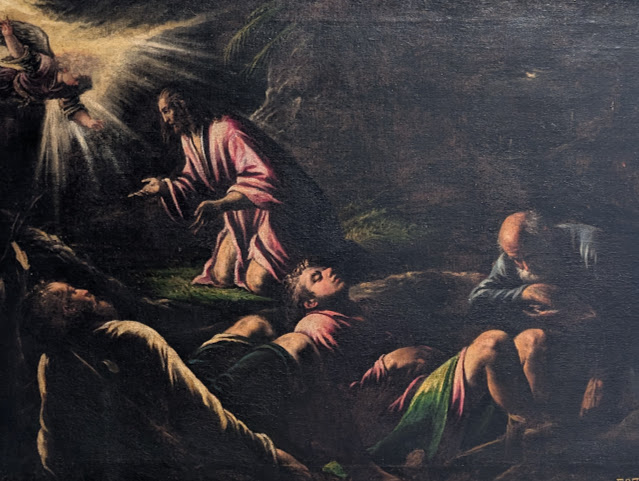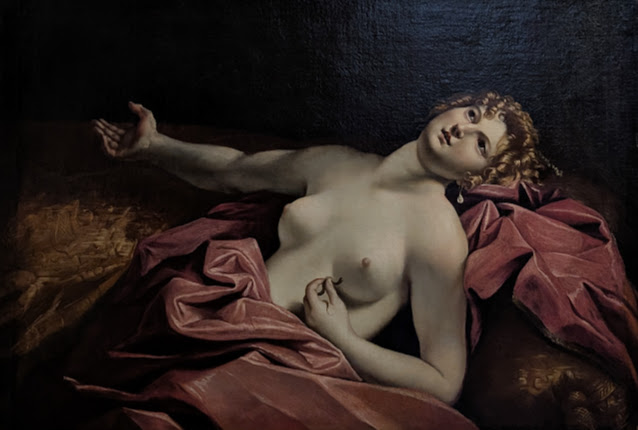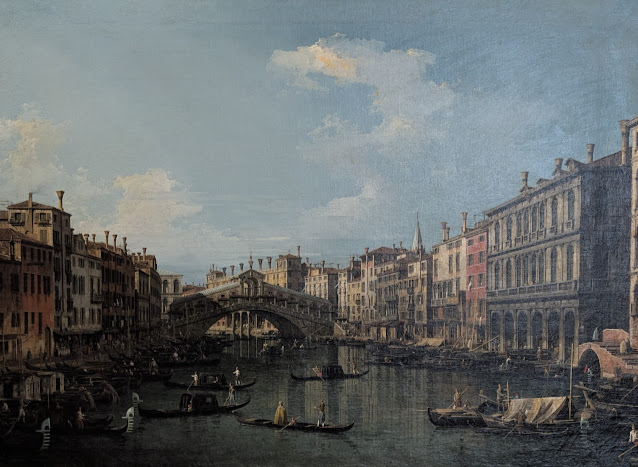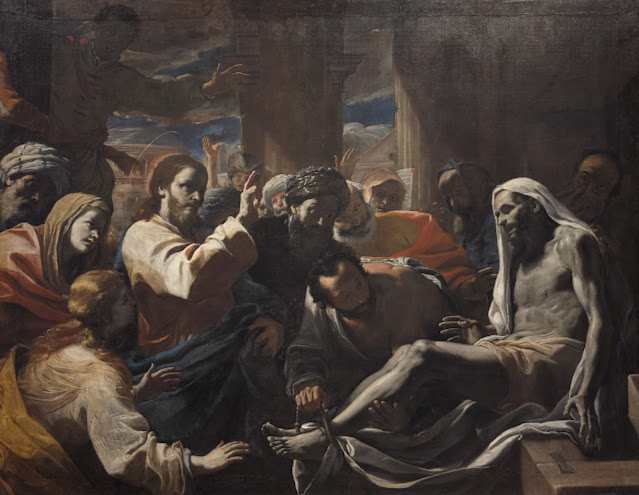I managed to visit the Palazzo Barberini in Rome. It is an absolute must for art lovers with a special focus on the Renaissance and Baroque.
I couldn’t get tickets to the Caravaggio exhibition which had sold out months in advance. But, still pleased to see Raphael, Titian, Artemisia Gentileschi ... I was pleased to come across Giovanni Lanfranco and Mattia Preti.
It was also a quiet refuge from the hussle-and-bussle of Rome.
I have uploaded a selection on the most interesting paintings/artists.
✲✲✲✲✲
The Annunciation by Fra Filippo Lippi
I absolutely love Fra Filippo Lippi.
Probably my favourite of the Italian early Renaissance.
I think he manages wonderfully infuse tenderness and humanism (with a certain wistfulness) whilst also preserves the elegance and dignity of a subject in the devotional art. Here, the Madonna is regal.
His use of perspective is innovative for its time. It’s as if we’re walking into a humble devotional abode.
✲✲✲✲✲
✲✲✲✲✲
Nativity with Saints Lawrence and Andrew by Antoniazzo Romano
✲✲✲✲✲
St Jerome in the Wilderness by Perugino
✲✲✲✲✲
Virgin and Child with St. Paul and St. Francis by Antoniazzo Romano
✲✲✲✲✲
St Philip Benizi by Perugino
✲✲✲✲✲
La Fornarina by Raphael
An exquisite & enigmatic painting by Raphael.
The soft warmth to her skin makes it feel intimate. A knowing and confident facial expression. She seems to be looking out of frame (and away from the viewer). Interesting headdress - symbolic or cultural? The sheer veil of modesty (covering her stomach) was a common theme denoting modesty and sensuality.
Giorgio Vasari talks about a mistress of Raphael’s whom he is reputed to have portrayed. Could this be his lover?
Art historians don’t know who she is. But she is an icon.
✲✲✲✲✲
Portrait of Erasmus of Rotterdam by Quentin Metsys
✲✲✲✲✲
Pope Urban VIII (a Barbarini) by Gian Lorenzo Bernini
✲✲✲✲✲
✲✲✲✲✲
Portrait of Pope Leo X with two Cardinals by Giuliano Bugiardini
✲✲✲✲✲
Portrait of Stefano Colonna by Bronzino
✲✲✲✲✲
Allegory of the Immaculate Conception by Giorgio Vasari
✲✲✲✲✲
The Entombment of Christ by Jacopino Del Conte
✲✲✲✲✲
Judith with the head of Holofernes by Jan Matsys
✲✲✲✲✲
Angel holding the lifeless body of Christ by Jacob de Backer
✲✲✲✲✲
The Agony in the Garden by Jacobo Bassano
✲✲✲✲✲
Venus and Adonis by Titian
✲✲✲✲✲
Christ and the Adulteress by Tinteretto
✲✲✲✲✲
Penitent Magdalene by Charles Mellin
✲✲✲✲✲
St. Luke Healing the Dropsical Child by Giovanni Lanfranco
In this gallery, I came across a number of Giovanni Lanfranco’s paintings. I had never come across his works before.
He was a contemporary of Caravaggio and it’s obvious with the dramatic lighting. An intense atmosphere with a moving depiction of Saint Luke as both doctor and saint to the little boy.
✲✲✲✲✲
St Jerome sealing a letter by Guercino
Very intense & stillness to Guercino (aka: “squinter”).
He painted this in the early part of his career (the “vigorous manner”): intense chiaroscuro and profound emotion.
He painted this before his move to Rome to work for Pope Gregory 15th.
Objects on the table (= candlestick and book) are a nod to the Saint’s intellect of translating the bible into latin.
Feet, slightly calloused and dirty — a symbol of his poverty and devotion?
✲✲✲✲✲
Saint Luke by Guercino
So very beautiful.
Another copy of this painting can be found in America.
This shows the interesting transition from the earlier strong chiaroscuro influence to a latter more “classical” approach.
I love the folds and intensity colour of St Luke’s robes. The bull (on the shelf) is a subtle clue to his iconography.
✲✲✲✲✲
Bust of Emperor Marcus Aurelius Antoninus
✲✲✲✲✲
Roman statue copy of Doryphoros of Polykleitos
✲✲✲✲✲
The suicide of Cleopatra by Giovanni Lanfranco
Capturing the tragedy of Cleopatra’s suicide.
A regal and defiant pose, a quiet dignity in her death.
And striking contrast between her pale skin and rich regal attire.
Another successful Baroque artist who lived in the same time as Caravaggio and Guercino. Guercino’s influence in the threaticality (rich colours, intensity of her pose) as she lays back against a chaise lounge.
Very happy to see Giovanni Lanfranco.
✲✲✲✲✲
Judith beheads Holofernes by Francesco Furini
Judith’s face is haunting and terrifying.
Her eyes. Wide and intense. Angry.
She’s a ferocious warrior with determination and focus as she carries out this gruesome task.
The 3rd party is Abra (Judith’s elderly assistant) and her expressions seems occluded.
✲✲✲✲✲
Portrait of the Quarantotti family by Marco Benefial
Never heard of this artist, but this was a wonderful painting.
The cleric in the painting is Giovanni Rattista. He commissioned the portrait. Clearly emphasising his “scared” status and oratory.
His family don’t seem that interested in him.
Everyone is showing off in this portrait.
Rather unusual family portrait, Benefial shows us a peculiar freedom.
✲✲✲✲✲
Female Nude from Behind by Pierre Subleyras
Pierre Subleyras was a French artist who lived in Rome. He won the Prix de Rome in his time which was a prestigious award to study in Rome.
Here the artist shows off his skill in capturing a private moment of beauty and vulnerability.
The nude was a subject of allegory and mythology, but it becomes something different here:
A naked woman is all we can see. Subleyras strips his subject of her clothes, and of any iconographic frills or anecdotal pretexts. We can’t recognize her as a goddess, a nymph, an allegory, nor do we know if it is just a model, a lover or the painter’s wife ... This woman’s identity escapes us. But who said that identity should be conveyed only through the exhibition of ritual effigy, of sumptuous dresses, of the symbols of roles? Intimacy opens a gap for itself overturning, quite literally, the conventions of official portrait painting ... Subleyras anticipates by a century the shock that another Frenchman, Eduard Manet, will cause with his Olympia, creating a much greater stir.
✲✲✲✲✲
View of the Rialto Bridge by Canaletto
Got to love Canaletto.
I’ve been on this bridge.
✲✲✲✲✲
View of Venice by Canaletto
✲✲✲✲✲
The Banquet of the Rich Glutton by Mattia Preti
First time coming across this artist. It seems he was a major Baroque artist.
The rich man indulging his pleasures ... with a beggar in the background.
A social commentary on inequality, perhaps? The glutton's gaze is quite intense. It makes us feel uncomfortable?
✲✲✲✲✲















































Your observations beautifully capture the emotional depth and timeless elegance of these masterpieces
ReplyDeleteI would love to see a painting by Artemisia Gentileschi.
ReplyDeleteThis is it = https://en.wikipedia.org/wiki/Self-Portrait_(Artemisia_Gentileschi,_Rome)
DeleteEven though you focused on Italian artists, Quentin Metsys was my favourite!
ReplyDeleteI am delighted he painted brilliant Erasmus in 1517, stressing not passionate reverence for the Holy Family but impressive religious tolerance and admiration of scholarship,
It was a surprising find, but it shows the wonderful cross inspiration of the Northern and Southern. :)
DeleteFabulous visit.
ReplyDeleteIt was, indeed.
DeleteYou were so lucky to visit and take photos. I like them all, of course some more than others but that is a choice and my taste.
ReplyDeleteVery lucky, I know. I'M very grateful to have these opportunities.
DeleteBeautiful masterpieces, thanks for sharing this fabulous art.
ReplyDeleteThank you Bill.
Delete